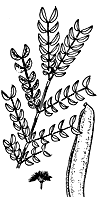View crop
View crop Data sheet EcoPortSamanea saman
 |
|
| Notes |
|---|
| BRIEF DESCRIPTION A large tree with a low, wide canopy reaching a height of 20-45 m, with a canopy spread of 55 m. The trunk diameter may be 80-200 cm. USES The timber is especially valued for woodcarvings and furniture, while other uses include heavy and light construction, boat building, boxes, fence posts, veneer, plywood, and fuel. Young leaves are used as forage. The pod pulp is edible and tastes like licorice. Whole pods can be ground into meal and used as animal feed. Roasted seeds are used as coffee substitute. The inner bark contains much gum and resin. The tree is often grown as an ornamental and for shade is valued as a pasture tree. GROWING PERIOD Perennial. Withstands a dry season of 2-4 months. COMMON NAMES Raintree, Saman, Samaan, Algarrobo, Monkeypod, French tamarind, Acacia. FURTHER INF Scientific synonym: Pithecellobium saman, Enterolobium saman, Mimosa saman, Inga Saman. Raintree is indigenous to the northern part of South America and the Caribbean Islands. The latitudinal range of natural occurrence is 11°N-5°S. It occurs in moderately sloping terrain near bottom lands at elevations from sea level to 700 m. Annual wood production potential is 25-35 m3/ha. It fixes nitrogen and is mentioned as a possible agroforestry species. | Sources |
| Grassland Index Webb D 1984 pp 240 [RAIN, TEMP, TEXT, PH, DRA, LIG, USE] National RC 1979 pp 202 INSPIRE species 157 [RAIN, TEMP, TEXT, PH, DRA, LIG, USE] Hensleigh T 1988 pp 280-284 [USE, FER, PH, TEXT, DRA, TEMP, RAIN, LIG, USE] Zabala N 1990 pp 76-78 [TEMP, RAIN, PH, TEXT, DRA, LIG, USE] |